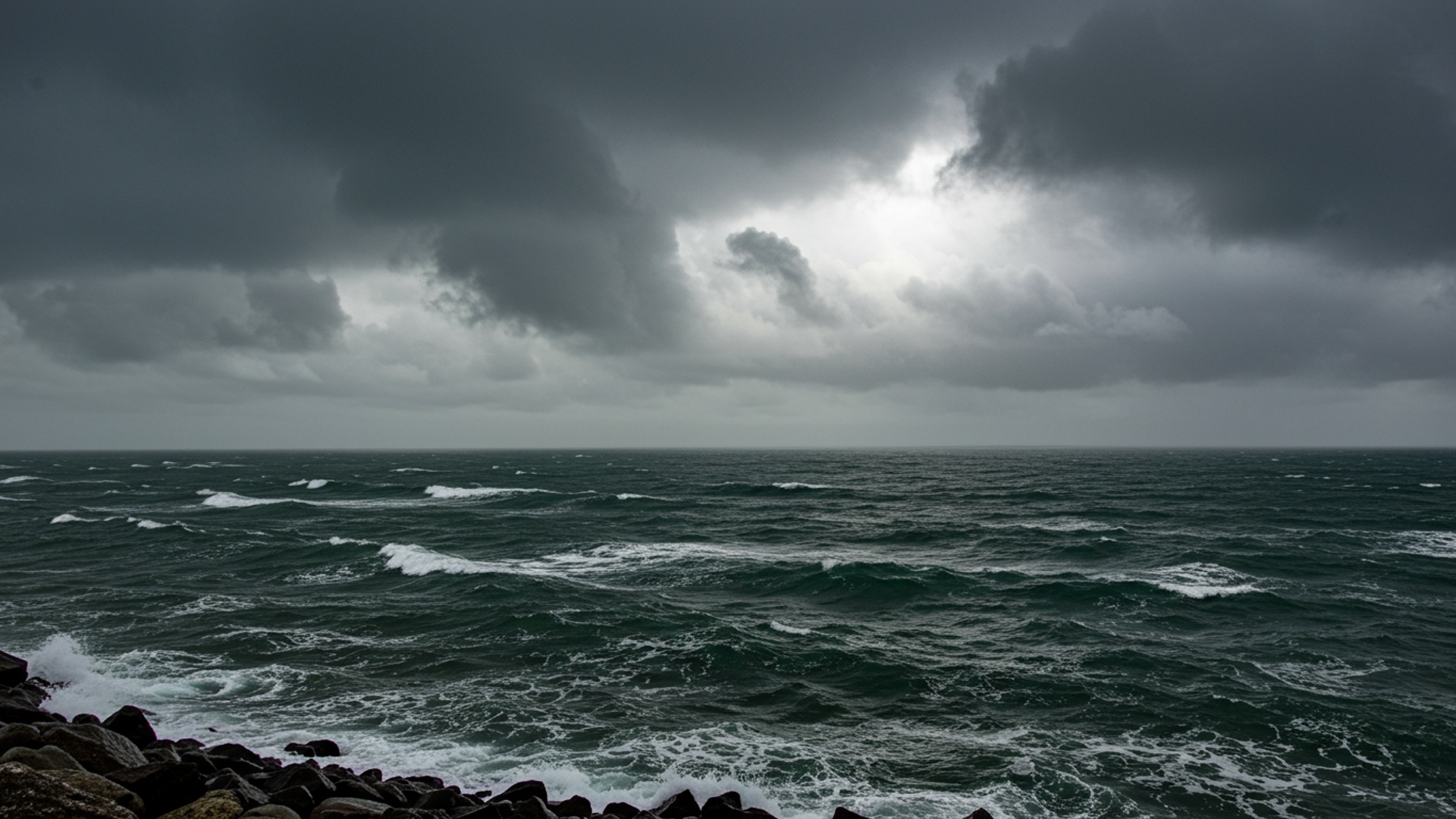A cyclone watch is now active for the Tamil Nadu coast as a strong weather system builds over the Bay of Bengal, posing a serious threat to coastal areas. The weather department issued the alert this morning, warning people in low-lying regions to be prepared for very strong winds and heavy rain. This comes as the Bay of Bengal shows signs of a deepening depression, which is likely to become a strong cyclone and cross the coast in the coming days. People living by the sea and in flood-prone areas must take immediate steps to keep safe.
Understanding the Early Warning
An early warning, known as a ‘Pre Cyclone Watch,’ has been put in place for the Tamil Nadu coast. This is the first step in a four-stage warning system used by the India Meteorological Department (IMD) to alert people about possible severe weather. The watch is issued 72 hours before a possible storm. It gives an early heads-up about a weather system forming in the North Indian Ocean that could turn into a tropical cyclone. It also points out the coastal areas that might see bad weather.
The main goal of this first warning is to tell the public and government bodies about the developing weather. This allows everyone to start getting ready before the weather gets worse. Such alerts are crucial because they give enough time for people to move to safer places and for disaster teams to get ready.
The IMD plays a key role in giving these warnings. Its top official, the Director General of Meteorology, sends out this initial ‘Pre Cyclone Watch’ to crucial government officials, including the Cabinet Secretary and chief secretaries of states along the coast. Local warning centers also help spread this insights widely.
Coastal Areas on High Alert
If the weather system grows stronger, several parts of Tamil Nadu’s coast could be affected. Areas like Chennai and its nearby districts are often among the first to be monitored. Other coastal areas that could face impacts include Cuddalore, Nagapattinam, Karaikal, Thoothukudi, Rameswaram. the Pamban coast, along with the Delta regions. These areas are known to be vulnerable to cyclones due to their location along the Bay of Bengal.
Early signs of a developing weather system, such as more humidity and scattered rain, are often seen in these regions before a storm fully forms. The IMD keeps a close watch on these conditions to give timely updates and more specific warnings as the weather system changes. This careful watching helps local people and authorities prepare better.
Potential effects from such weather systems include heavy rainfall, strong winds. high sea waves. These can cause damage to simple homes, break tree branches. affect power and phone lines. It is vital for people in these coastal areas to pay close attention to all official updates.
Government Actions to Get Ready
State and national teams are already working to prepare for any bad weather. The Tamil Nadu State Disaster Management Authority (TNSDMA) is leading the efforts at the state level. This body is in charge of making plans for managing disasters, making sure they are followed. working with other groups to respond to emergencies.
Specific actions being taken include:
- Setting up relief centers and making sure they have enough supplies.
- Cleaning out drains and cutting down weak trees that could fall in strong winds.
- Making sure there is backup power and food in remote villages.
- Deployment of teams from the National Disaster Response Force (NDRF) and State Disaster Response Force (SDRF) to key areas. These teams help with rescue, relief. moving people to safer places.
“The state government’s quick actions come as Tamil Nadu gets ready for possible impacts of the coming cyclonic storm. Officials were told to make sure relief centers are ready and that people from low-lying areas are moved to safety early.”
The Chief Minister has also held meetings to check on the state’s readiness. Directions have been given to ensure that crops are protected from rain and wind. that electricity supply remains stable in affected areas. Government engineers are checking public buildings and shelters to make sure they are strong enough to withstand the weather.
vital Warnings for Fishermen
Fishermen along the Tamil Nadu coast have been given clear warnings to stay away from the sea. This is a very essential step to keep them safe. The IMD and fisheries department have told fishermen to strictly avoid going out to sea during this period.
Ports along the coast have raised specific signal flags, like Signal flags 2 and 3, at places such as Chennai and Nagapattinam ports. These flags tell ships and boats about the coming bad weather. Fishing boats that are already at sea are being contacted through various ways, including satellite phones provided by the government. There are also coordination centers and local churches that help spread the word. The Indian Coast Guard also helps warn fishermen from their ships.
In the past, to stop fishermen from going out in rough weather, fishing tokens were not given out. Modern tools are also helping. For example, a mobile app called “Thoondil” gives fishermen weather details and shows them where safe shores are, even when there is no internet. These efforts show how essential it is to get timely data to those whose lives depend on the sea.
Guidance for Coastal Residents
With the cyclone watch in place, residents living along the coast and in nearby areas are advised to take several steps to keep themselves and their families safe. The Tamil Nadu government has shared a detailed checklist for cyclone readiness. These tips are for everyone, no matter if they live right on the coast or a bit further inland.
Here are some key actions residents should take:
- Make sure all electronic devices, like mobile phones and power banks, are fully charged.
- Stay indoors and keep away from windows if the weather turns bad.
- Do not travel unless it is absolutely necessary.
- If local officials tell you to move, go to the nearest relief shelter right away. Help elderly people, those with disabilities. children get to safety first.
- Keep a supply of dry snacks and clean water for at least two days.
- Store vital documents in waterproof covers to protect them.
- Keep a written list of emergency contact numbers, not just on your phone.
- Have battery-powered torches or candles ready for power cuts.
- Listen to official updates from trusted sources like the IMD on radio and through SMS alerts.
- Boil or purify water before drinking it to prevent illness.
- After the storm, do not go near fallen power lines or broken poles.
- Only return to affected areas when local authorities say it is safe.
“The Tamil Nadu State Disaster Management Authority (TNSDMA) is also sending out SMS alerts and weather warnings to all registered mobile numbers in affected areas.”
It is crucial for people to avoid spreading unconfirmed news and to rely only on official reports to ensure their safety and the safety of their communities.
Learning from Past Experiences
Tamil Nadu has a history of facing severe cyclones. each experience has helped the state get better at preparing and responding. Cyclones like Nivar, Mandous, Michaung, Ockhi. Thane have caused significant impact in previous years. These events have shown the importance of strong early warning systems and quick community action.
For example, after Cyclone Ockhi in 2017, which greatly affected fishermen, the Tamil Nadu government, with help from central agencies, set up a better communication system for those at sea. This three-tier system helps warn fishermen who go far into the ocean. The lessons learned from the 2015 floods also prepared local fishermen to act quickly in rescue operations during Cyclone Michaung in 2023, even before official calls.
The state has focused on building a culture of readiness at every household level. This means every resident knows what to do before, during. after a cyclone. Efforts include developing natural barriers along coastal areas, like bio-shields, to help reduce damage from strong winds. The continuous improvement in forecasting tools and communication methods by agencies like the IMD also plays a vital role in saving lives and reducing property loss.
Roles of Key Agencies in Disaster Readiness
Several government agencies work together to manage cyclone threats and help the public. Their combined efforts ensure that warnings are given, preparations are made. help is available during and after a storm.
India Meteorological Department (IMD)
The IMD is the main agency responsible for watching weather systems and giving out warnings. It issues cyclone warnings in four stages, starting with the ‘Pre Cyclone Watch’ 72 hours in advance. The IMD provides detailed data on the storm’s location, strength, likely path. expected rainfall and wind speeds. They also use advanced tools and technology to make accurate forecasts.
Tamil Nadu State Disaster Management Authority (TNSDMA)
The TNSDMA is the top body for managing disasters at the state level. It makes policies and plans for disaster preparedness, reducing risks. responding to emergencies. The TNSDMA works to coordinate all parts of the government and other groups to ensure a united approach to disaster management. It also looks at development plans to make sure they include ways to prevent and lessen disaster impact.
“The State Disaster Management Authority (SDMA) plays a vital role in making sure states are safe, strong. ready for disasters. It is the main body that helps with preventing disasters, reducing their effects, responding to them. helping people recover.”
The TNSDMA monitors relief, rescue. rehabilitation work to reduce damage and support affected communities.
National Disaster Response Force (NDRF)
The NDRF is a specialized force set up by the central government to respond to major disasters. NDRF teams are sent to vulnerable areas to help with evacuations, search and rescue operations. to provide immediate help and medical care. They also help local governments and raise public awareness about how to reduce disaster risks.
State Disaster Response Force (SDRF)
Similar to the NDRF, the SDRF operates at the state level. These teams work closely with the NDRF and local administration during emergencies. They are deployed to districts expected to be hit hard by the cyclone to help with preparedness and response activities, including moving people to safety and handling emergency situations.
These agencies work together to create a strong safety network, ensuring that communities are informed, prepared. supported during cyclone threats.
![]()













